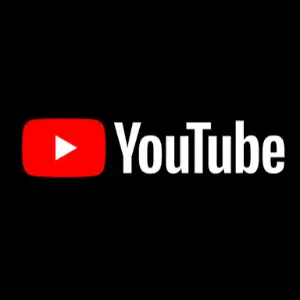In November 2006, almost two years after its founding in February 2005, Google acquired YouTube for a then-hefty price of $1.65 billion.
In the 2021 annual report, Google reported that YouTube generated $28.8 billion from advertisements alone in 2021 (Youtube generates revenue through other income streams as well, which we will discuss below), contributing 11.19% to Google’s total 2021 revenue.
Youtube has, undoubtedly, been one of the most remarkable acquisitions in the history of tech. It is the second most popular website in the world after Google.
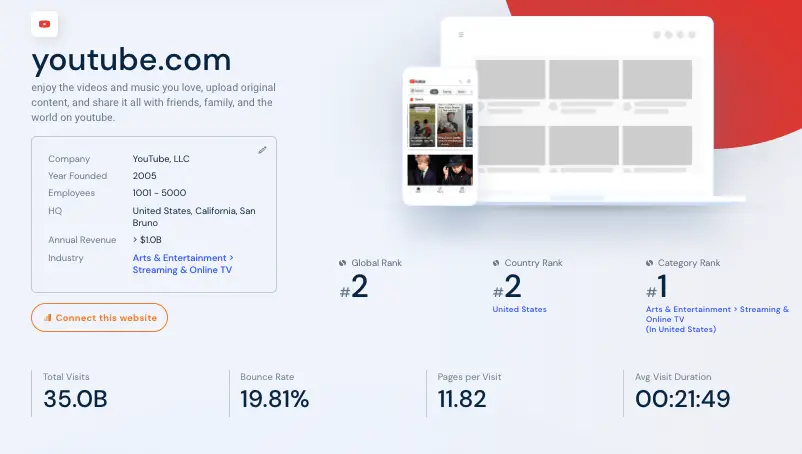
Source: Similar Web
But when it comes to engagement metrics like avg visit duration, pages per visit & bounce rate, Youtube is second to none, not even Google. YouTube has an avg visit duration of 21.49 mins, with users viewing 11.82 pages per visit and an incredibly low bounce rate of 19.81%. On the other hand, Google, YouTube’s parent company, has an avg visit duration of 10.48 mins, with users viewing 8.70 pages per visit and a bounce rate of 28.51%.
Since Google acquired it, YouTube has evolved significantly, both in terms of functionality and income streams. In this blog, we will discuss YouTube’s founding story & product evolution, YouTube’s business model, and learn whether it is profitable or not.
How YouTube Started
Like many other startups, the original idea of YouTube was way different than what it has grown to become. Initially, the platform was supposed to be an online dating site.

Started by three ex-PayPal employees — Chad Hurley, Steve Chen, and Jawed Karim — YouTube pivoted to becoming a user-generated video-sharing platform after the original dating site idea failed to get traction.
Years later, Jawed said that two disparate incidents — Janet Jackson’s infamous wardrobe malfunction & Indonesian Tsunami gave birth to the idea of YouTube. Although everyone was talking about these incidents and plenty of videos were shot, it was impossible to find any video clips online because it took hours to upload videos on the web at the time.
Chad & Steve, however, have a different story to share — one that has been often repeated in the media. According to them, the idea for YouTube came after a dinner party at Chen’s apartment in San Francisco, when the duo experienced difficulty uploading videos they had shot. To this, Jawed responded that not only did he never attend the party, but it also never occurred.
Steve later acknowledged that the idea that the notion of YouTube being founded after a dinner party “was probably very strengthened by marketing ideas around creating a story that was very digestible.”
Due to the discrepancy between the stories shared by the founder, we can never really know how exactly the idea of YouTube came to be but Wayback Machine’s first captured screenshot of YouTube confirms that it was initially supposed to be a dating site, not a user-generated video platform.
Anyways, moving on from that, the first video to be uploaded on the platform was a 19-second clip titled ‘Me at the Zoo’ (watched over 244 million times now), uploaded by co-founder Jawed Karim in April 2005. The first video to go viral and achieve the one million views landmark was a Nike ad, featuring former Brazilian player Ronaldinho in November 2005. In the same month, Sequoia Capital invested $3.5 million dollars in the platform.
Youtube launched officially on 15th December 2005, before which it was in Beta. By launch time, the platform was receiving 8 million views in a day. Youtube grew from strength to strength thereafter, but growth came with its own set of challenges. The platform would frequently run out of storage capacity, forcing the company to buy more and more of it.
To top that off, the company also had to allocate finances to litigation, as many media companies discovered that some of the videos uploaded contained copyrighted material. With continuously growing costs and limited success in monetizing the platform, YouTube began looking for a buyer. Google’s video platform launched in 2005 had failed, so they decided to buy YouTube for $1.65 billion in November 2006.
After the acquisition, YouTube expanded to the UK & 8 other countries in 2007. Its mobile version was launched in the same year as well, letting smartphone users access the platform on a mobile-optimized site.
By May 2008, 13 hours of video were being uploaded on YouTube every minute & Forbes estimated YouTube’s annual revenue to be around $200 million. In 2009, the company launched full HD, which helped accelerate its journey to achieving the milestone of one billion daily views.
YouTube achieved yet another milestone in December 2012, when ‘Gangnam Style’ became the first video to reach one billion views. Fast forward to 2022, YouTube has over 2 billion monthly logged-in users watching over a billion hours of video watched daily.
YouTube Business Model
YouTube primarily makes money through advertising and secondarily through its YouTube premium subscription business. Other than these two sources, YouTube also earns revenue from Channel Memberships, YouTube TV, Super Chats, Super Stickers, Super Thanks & Merchandise. YouTube shares revenue generated from these shared channels with creators in most cases.
To develop a detailed understanding of YouTube’s different revenue channels, let’s take a look at the segments individually.
1. Advertisements
A wise techie once said, “If You’re Not Paying for It, You’re the Product.” All of us can watch videos on YouTube for free because it monetizes us by selling our attention to eyeball-hungry advertisers.
55% of the ad revenue is paid to video creators who join the YouTube Partner Program, incentivizing creators to keep creating and uploading videos. YouTube takes the remaining 45% cut.
When Google released its 2019 fourth-quarter earnings report in February 2020, the world got to know YouTube’s contribution to Google’s baseline for the first time. Until then, Google had never officially revealed how much revenue YouTube generated.
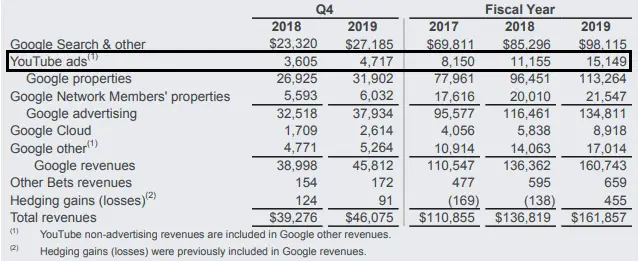
In three years, from 2017 to 2019, YouTube generated more than $34 billion, only in ad revenue, with ad earnings growing incredibly year on year. YouTube made $19.7 billion & $28.8 billion in 2020 and 2021, respectively. The growth that YouTube’s ad business has seen since 2017 indicates the growing strength of YouTube in the video ad market.
At $28.8 billion, YouTube’s advertising revenue is a little more than one-fourth the size of Facebook’s advertising business, which made around $117,929 billion in 2021.
2. YouTube Premium
Youtube premium, formerly YouTube Red, is a subscription-based freemium service that bundles the following together:
- Ad-free Youtube access, downloading videos for offline viewing & watching videos in the background while using other apps.
- Ad-free access to millions of songs on YouTube Music, downloading music for offline listening & playing songs in the background while using other apps.
- Ad-free access to YouTube kids and offline viewing.
The YouTube Premium service is available at $11.99/month in the USA. YouTube Music is also available separately for $9.99/month, a price at which it makes less sense to buy the service individually. Pricing for YouTube Premium & YouTube Music differs as per country. As of Sep 2021, YouTube Premium had 50 million Music and Premium subscribers.
3. Channel Memberships
Launched in January 2018, Channel Memberships is a Patreon-like feature that allows viewers to become paid members of YouTube channels they like and want to support. For YouTubers, memberships provide an additional source of income apart from the advertising share they receive from YouTube.
In exchange for subscribing, channel supporters get access to perks like Member-exclusive posts, Loyalty badges & Exclusive emojis. The most basic channel membership costs $4.99 in the US, with upgrades available to higher tiers, which have more perks and higher pricing.
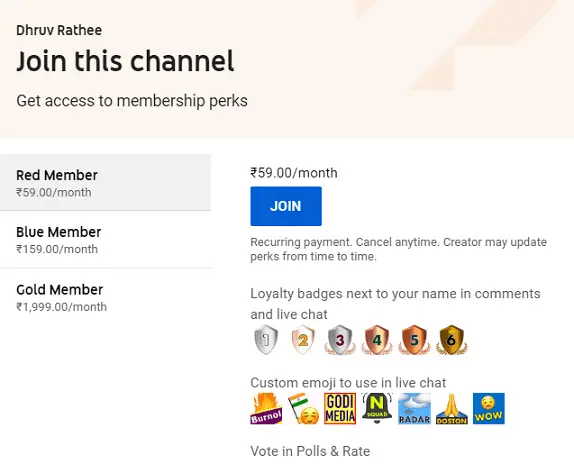
Regarding membership revenue split, YouTubers receive 70% of the membership amount & YouTube takes 30% for playing the role of an intermediary.
4. Super Chat, Super Stickers, Super Thanks & Merchandise
Super chats, Super stickers, Super Thanks & Merchandise give YouTubers an alternative source of income generation, similar to channel memberships. Using Superchat, viewers can pay to pin their comments at the top during live streams. The more the users pay, the longer their comment gets pinned. Super stickers are animated graphics that users can purchase to comment during live streams. Super Thanks is a way for YouTube creators to get paid directly by fans for pre-recorded or uploaded content.
Whatever extra money YouTubers make from Super chat and Super stickers & Super Thanks, YouTube keeps 30% of it and gives the remaining 70% to the channel owners.
In case you’ve not seen them, here’s how Superchat & Superstickers look.
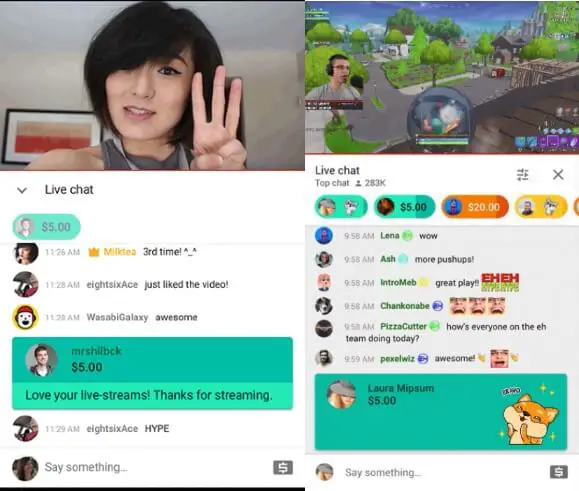
While selling merchandising by redirecting users to their merch store has been a part of YouTube creators’ monetization sources for a long time, what YouTube merchandise does is that it supports displaying products on a shelf directly below videos. YouTube has partnered with several online stores like Teespring, DFTBA, Shopify for enabling merchandise sales.
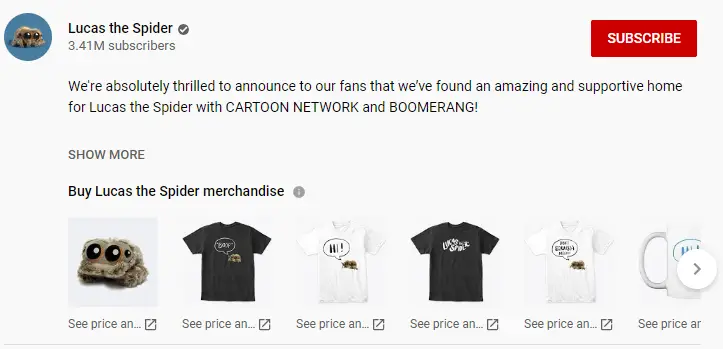
In the case of Teespring, the company takes a fixed price per item sold, but the creator can set any price he wants for the product. YouTube receives a small commission from Teespring for every sale, which YouTube then returns to the creators most of the time so that they earn more money than would by operating their store, incentivizing channel owners to sell through YouTube.
5. YouTube TV
A US-exclusive subscription-based, live TV streaming service, YouTube TV bundles together content from 85+ top channels like ABC, FOX, NBC, ESPN, CNN & many more. At $64.99/month, YouTube TV comes with 6 accounts per household & unlimited cloud storage.
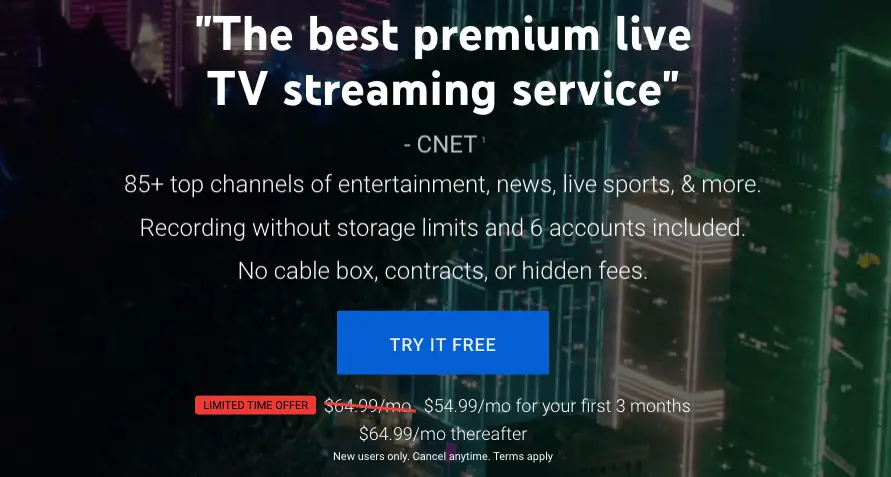
As of Sep 2021, YouTube TV had 4 million subscribers.
Is YouTube Profitable?
Nobody knows if YouTube is profitable as an independent entity, except of course the high-tier folks at Google. While YouTube has generated a revenue of $82.95 billion from ads alone from 2017 to 2021, Google does not provide a profitability breakdown for individual segments in its Annual earning reports. Google also doesn’t provide a breakdown of revenue generated from other YouTube sources, like the ones we discussed above, making it even more difficult to determine YouTube’s profitability.
Read More Case Studies
WhatsApp’s Business Model Case Study
Tesla Business Model Case Study
Instagram Business Model Case Study
